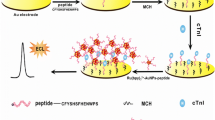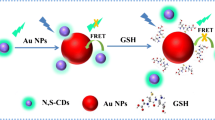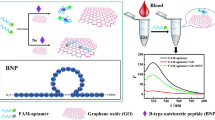Abstract
Simple and sensitive detection of cardiac biomarkers is of great significance for early diagnosis and prevention of acute myocardial infarction (AMI). Here, a ratiometric fluorescent nanohybrids probe (AuNCs-QDs) was synthesized through the coupling of bovine serum albumin-functionalized gold nanoclusters (AuNCs) with CdSe/ZnS quantum dots (QDs) to realize simple and sensitive detection of cardiac biomarker myoglobin (Mb). The AuNCs-QDs probe shows pink fluorescence under UV light, with two emission peaks at 468 nm and 630 nm belonging to QDs and AuNCs, respectively. Importantly, the presence of Mb caused fluorescence quenching of the blue-emitting QDs, thereby inhibiting the fluorescence resonance energy transfer (FRET) process between QDs and AuNCs, and reducing the fluorescence intensity ratio (F468/F630) of AuNCs-QDs probe effectively. As the concentration of Mb increases, the ratiometric fluorescent probe also exhibits a visible fluorescence color change. The detection limit was as low as 4.99 μg/mL, and the response of the probe to Mb showed a good linear relationship up to 0.52 mg/mL. Moreover, the probe has excellent specificity for Mb. Besides, the AuNCs-QDs has been applied to detect Mb of urine samples. More importantly, we also developed an AuNCs-QDs probe modified smartphone-aided paper-based strip for on-site monitoring of Mb. As far as we know, this is the first report of a smartphone-aided paper-based strip for on-site quick monitoring of Mb, which provides a useful approach for AMI biomarker monitoring and may can be extended to other medical diagnostics.









Similar content being viewed by others
Code Availability
Not applicable.
Availability of Data and Material
Unpublished data.
References
Anderson JL, Morrow DA (2017) Acute myocardial infarction. N Engl J Med 376:2053–2064. https://doi.org/10.1056/NEJMra1606915
White HD, Thygesen K, Alpert JS (2007) Universal definition of myocardial infarction. J Am Coll Cardiol 50:2173–2195. https://doi.org/10.1093/eurheartj/ehn130
de Haan JJ, Smeets MB, Pasterkamp G, Arslan Danger F (2013) Signals in the initiation of the inflammatory response after myocardial infarction. Mediators Inflamm 2013:206039–206051. https://doi.org/10.1155/2013/206039
Mythili S, Malathi N (2015) Diagnostic markers of acute myocardial infarction. Biomed Rep 3:743–748. https://doi.org/10.3892/br.2015.500
Lim WY, Thevarajah TM, Goh BT, Khor SM (2019) Paper microfluidic device for early diagnosis and prognosis of acute myocardial infarction via quantitative multiplex cardiac biomarker detection – ScienceDirect. Biosens Bioelectron 128:176–185. https://doi.org/10.1016/j.bios.2018.12.049
Chan CPY, Wan TSM, Watkins KL, Pelsers MMAL, Van der Voort D, Tang FPW, Lam KHK, Mill J, Yuan Y, Lehmann M, Hempel A, Sanderson JE, Glatz JFC, Renneberg R (2015) Rapid analysis of fatty acid-binding proteins with immunosensors and immunotests for early monitoring of tissue injury. Biosens Bioelectron 20:2566–2580. https://doi.org/10.1016/j.bios.2004.09.028
Suprun EV, Shilovskaya AL, Lisitsa AV, Bulko TV, Shumyantseva VV, Archakov AI (2011) Electrochemical immunosensor based on metal nanoparticles for cardiac myoglobin detection in human blood plasma. Electroanalysis 23:1051–1057. https://doi.org/10.1002/elan.201000668
Moreira FTC, Sharma S, Dutra RAF, Noronha JPC, Cass AEG, Sales MGF (2015) Detection of cardiac biomarker proteins using a disposable based on a molecularly imprinted polymer grafted onto graphite. Microchim Acta 182:975–983. https://doi.org/10.1007/s00604-014-1409-0
Osman B, Uzun L, Beşirli N, Denizli A (2013) Microcontact imprinted surface plasmon resonance sensor for myoglobin detection. Mater Sci Eng C 33:3609–3614. https://doi.org/10.1016/j.msec.2013.04.041
Gnedenko OV, Mezentsev YV, Molnar AA, Lisitsa AV, Ivanov AS, Archakov AI (2013) Highly sensitive detection of human cardiac myoglobin using a reverse sandwich immunoassay with a gold nanoparticle-enhanced surface plasmon resonance biosensor. Anal Chim Acta 759:105–109. https://doi.org/10.1016/j.aca.2012.10.053
Liu T, Fu L, Yin C, Wu M, Chen L, Niu N (2022) Design of smartphone platform by ratiometric fluorescent for visual detection of silver ions. Microchem J 174:107016–107024. https://doi.org/10.1016/J.MICROC.2021.107016
Zhang Y, Yang M, Shao Z, Xu H, Liao X (2020) A paper-based fluorescent test for determination and visualization of cysteine and glutathione by using gold-silver nanoclusters. Microchem J 158:105327–105334. https://doi.org/10.1016/j.microc.2020.105327
Li H, Lin H, Lv W, Gai P, Li F (2020) Equipment-free and visual detection of multiple biomarkers via an aggregation induced emission luminogen-based paper biosensor. Biosens Bioelectron 165:112336–112343. https://doi.org/10.1016/j.bios.2020.112336
Wang J, Ren L, Wang X, Wang Q, Wan Z, Li L, Liu W, Wang X, Li M, Tong D, Liu A, Shang B (2009) Superparamagnetic microsphere-assisted fluoroimmunoassay for rapid assessment of acute myocardial infarction. Biosens Bioelectron 24:3097–3102. https://doi.org/10.1016/j.bios.2009.03.033
Shorie M, Kumar V, Sabherwal P, Ganguli A (2015) Carbon quantum dots-mediated direct fluorescence assay for the detection of cardiac marker myoglobin. Curr Sci 108:1595–1596. http://www.jstor.org/stable/24905522. Accessed 10 May 2023
Liu D, Zeng Y, Zhou G, Lu X, Miao D, Yang Y, Zhai Y, Zhang J, Zhang Z, Wang H (2019) Fluorometric determination of cardiac myoglobin based on energy transfer from a pyrene-labeled aptamer to graphene oxide. Microchim Acta 186:1–6. https://doi.org/10.1007/s00604-019-3385-x
Gui R, Jin H, Bu X, Fu Y, Wang Z, Liu Q (2019) Recent advances in dual-emission ratiometric fluorescence probes for chemo/biosensing and bioimaging of biomarkers. Coord Chem Rev 383:82–103. https://doi.org/10.1016/j.ccr.2019.01.004
Zhang Y, Xu H, Chen Y, You X, Pu Y, Xu W, Liao X (2020) High-sensitivity detection of cysteine and glutathione using Au nanoclusters based on aggregation-induced emission. J Fluoresc 30:1491–1498. https://doi.org/10.1007/s10895-020-02618-8
Yang J, Huang Y, Cui H, Li L, Ding YP (2022) A FRET fluorescent sensor for ratiometric and visual detection of sulfide based on carbon dots and silver nanoclusters. J Fluoresc 32:1815–1823. https://doi.org/10.1007/s10895-022-02981-8
Fu Q, Zhou X, Wang M, Su X (2022) Nanozyme-based sensitive ratiometric fluorescence detection platform for glucose. Anal Chim Acta 1216:339993–340000. https://doi.org/10.1016/J.ACA.2022.339993
Yu X, Zhang C, Zhang L, Xue Y, Li H, Wu Y (2018) The Construction of a FRET Assembly by Using Gold Nanoclusters and Carbon Dots and their Application as a Ratiometric Probe for Cysteine Detection. Sens Actuators B Chem 263:327–335. https://doi.org/10.1016/j.snb.2018.02.072
Shi G, Zhu A, Qi Y, Zhang M (2015) Terbium(III)/gold nanocluster conjugates: the development of a novel ratiometric fluorescent probe for mercury(II) and a paper-based visual sensor. Analyst 140:5656–5661. https://doi.org/10.1039/c5an00802f
Liu W, Wang X, Wang Y, Li J, Shen D, Kang Q, Chen L (2018) Ratiometric fluorescence sensor based on dithiothreitol modified carbon dots-gold nanoclusters for the sensitive detection of mercury ions in water samples. Sens Actuators B Chem 262:810–817. https://doi.org/10.1016/j.snb.2018.01.222
Huang X, Jiang H, Li Y, Sang L, Zhou H, Shahzad SA, Ibupoto ZH, Yu C (2017) Synthesis of silica nanoparticles doped with [Ru(bpy)3]2+ and decorated with silver nanoclusters for the ratiometric photoluminescent determination and intracellular imaging of Cu(II) ions. Microchim Acta 184:2325–2331. https://doi.org/10.1007/s00604-017-2206-3
Wang C, Lin H, Xu Z, Huang Y, Humphrey MG, Zhang C (2016) Tunable carbon-dot-based dual-emission fluorescent nanohybrids for ratiometric optical thermometry in living cells. ACS Appl Mater Inter 8:6621–6628. https://doi.org/10.1021/acsami.5b11317
Niu W, Shan D, Zhu R, Deng S, Cosnier S, Zhang X (2016) Dumbbell-shaped carbon quantum dots/AuNCs nanohybrid as an efficient ratiometric fluorescent probe for sensing cadmium (II) ions and l -ascorbic acid. Carbon 96:1034–1042. https://doi.org/10.1016/j.carbon.2015.10.051
Han B, Li Y, Hu X, Yan Q, Jiang J, Yu M, Peng T, He G (2018) Paper-based visual detection of silver ions and L-cysteine with a dual-emissive nanosystem of carbon quantum dots and gold nanoclusters. Anal Methods 10:3945–3950. https://doi.org/10.1039/C8AY01044G
Wen Z, Song S, Hu T, Wang C, Qu F, Wang P, Yang M (2019) A dual emission nanocomposite prepared from copper nanoclusters and carbon dots as a ratiometric fluorescent probe for sulfide and gaseous H2S. Microchim Acta 186:1–8. https://doi.org/10.1007/s00604-019-3295-y
Wang X, Duan Q, Zhang B, Cheng X, Wang S, Sang S (2021) Ratiometric fluorescence detection of Cd2+ based on N. S co-doped carbon quantum dots/Au nanoclusters. Microchem J 167:106269–106275. https://doi.org/10.1016/j.microc.2021.106269
Ge H, Zhang K, Yu H, Yue J, Yu L, Chen X, Hou T, Alamry KA, Marwani HM, Wang S (2018) Sensitive and selective detection of antibiotic D-penicillamine based on a dual-mode probe of fluorescent carbon dots and gold nanoparticles. J Fluoresc 28:1405–1412. https://doi.org/10.1007/s10895-018-2307-3
Zhang Y, Xu H, Yang Y, Zhu F, Pu Y, You X, Liao X (2021) Efficient fluorescence resonance energy transfer-based ratiometric fluorescent probe for detection of dopamine using a dual-emission carbon dot-gold nanocluster nanohybrid. J Photochem Photobiol A 411:113195–113202. https://doi.org/10.1016/j.jphotochem.2021.113195
Wang N, Ga L, Ai J (2018) Synthesis of novel fluorescent copper nanomaterials and their application in detection of iodide ions and catalysis. Anal Methods 11:44–48. https://doi.org/10.1039/C8AY01871E
Mathew A, Pradeep T (2015) Noble metal clusters: applications in energy, environment, and biology. Part Part Syst Charact 31:1017–1053. https://doi.org/10.1002/ppsc.201400033
Al-mashriqi HS, Cai M, Qi S, Zhai HL (2023) BSA capped gold nanoclusters modulated by copper ion for sensitive and selective detection of histidine in biological fluid. J Fluoresc 33:697–706. https://doi.org/10.1007/s10895-022-03112-z
Qiu Q, Gao R-R, Xie A, Jiao Y, Dong W (2020) A ratiometric fluorescent sensor with different DNA-templated Ag NCs as signals for ATP detection. J Photochem Photobiol A Chem 400:112725–112731. https://doi.org/10.1016/j.jphotochem.2020.112725
Zhang Z, Liu T, Wang S, Ma J, Zhou T, Wang F, Wang X, Zhang G (2019) DNA-templated gold nanocluster as a novel fluorometric sensor for glutathione determination. J Photochem Photobiol A Chem 370:89–93. https://doi.org/10.1016/j.jphotochem.2018.10.021
Wang W, Li J, Fan J, Ning W, Liu B, Tong C (2018) Ultrasensitive and non-labeling fluorescence assay for biothiols using enhanced silver nanoclusters. Sens Actuators B Chem 267:174–180. https://doi.org/10.1016/j.snb.2018.04.010
Liu Z, Wu Z, Yao Q, Cao Y, Chai OJH, Xie J (2021) Correlations between the fundamentals and applications of ultrasmall metal nanoclusters: Recent advances in catalysis and biomedical applications. Nano Today 36:101053–101075. https://doi.org/10.1016/j.nantod.2020.101053
Xu X, Ray R, Gu Y, Ploehn HJ, Gearheart L, Raker K, Scrivens WA (2004) Electrophoretic analysis and purification of fluorescent single-walled carbon nanotube fragments. J Am Chem Soc 126:12736–12737. https://doi.org/10.1021/ja040082h
Sun Y, Zhou B, Lin Y, Wang W, Fernando KAS, Pathak P, Meziani MJ, Harruff BA, Wang X (2006) Quantum-sized carbon dots for bright and colorful photoluminescence. J Am Chem Soc 128:7756–7757. https://doi.org/10.1021/JA062677D
Huang G, Chen X, Wang C, Zheng H, Huang Z, Chen D, Xie H (2017) Photoluminescent carbon dots derived from sugarcane molasses: synthesis, properties, and applications. RSC Adv 7:47840–47847. https://doi.org/10.1039/C7RA09002A
Wang R, Lu K, Tang Z, Xu Y (2017) Recent progress in carbon quantum dots: synthesis, properties and applications in photocatalysis. J Mater Chem A 5:3717–3734. https://doi.org/10.1039/C6TA08660H
Yuan F, Li S, Fan Z, Meng X, Fan L, Yang S (2016) Shining carbon dots: Synthesis and biomedical and optoelectronic applications. Nano Today 11:565–586. https://doi.org/10.1016/j.nantod.2016.08.006
Borse S, Jha S, Murthy ZVP, Kailasa SK (2022) Sustainable chemistry approach for the preparation of bluish green emissive copper nanoclusters from Justicia adhatoda leaves extract: a facile analytical approach for the sensing of myoglobin and l-thyroxine. New J Chem 46:15919–15928. https://doi.org/10.1039/d2nj02524h
Chen J, Ran F, Chen Q, Luo D, Ma W, Han T, Wang C, Wang C (2019) A fluorescent biosensor for cardiac biomarker myoglobin detection based on carbon dots and deoxyribonuclease I-aided target recycling signal amplification. RSC Adv 9:4463–4468. https://doi.org/10.1039/C8RA09459D
Miao D, Liu D, Zeng Y, Zhou G, Xie W, Yang Y, Wang H, Zhang J, Zhai Y, Zhang Z, Li L (2020) Fluorescent aptasensor based on D-AMA/F-CSC for the sensitive and specific recognition of myoglobin. Spectrochim. Acta A Mol Biomol Spectrosc 228:117714–117719. https://doi.org/10.1016/j.saa.2019.117714
Wang Q, Yang X, Yang X, Liu F, Wang K (2015) Visual detection of myoglobin via G-quadruplex DNAzyme functionalized gold nanoparticles-based colorimetric biosensor. Sens Actuators B Chem 212:440–445. https://doi.org/10.1016/j.snb.2015.02.040
Sullivan MV, Stockburn WJ, Hawes PC, Mercer T, Reddy SM (2021) Green synthesis as a simple and rapid route to protein modified magnetic nanoparticles for use in the development of a fluorometric molecularly imprinted polymer-based assay for detection of myoglobin. Nanotechnology 32:095502–095514. https://doi.org/10.1088/1361-6528/abce2d
Sun C, Wang D, Geng Z, Gao L, Zhang M, Bian H, Liu F, Zhu Y, Wu H, Xu W (2015) One-step green synthesis of a polypyrrole-Au nanocomposite and its application in myoglobin aptasensor. Anal Methods 7:5262–5268. https://doi.org/10.1039/c5ay01006c
Funding
This work was supported by National Natural Science Key Foundation of China (Project no. 12032007), Chongqing Talents (cstc2022ycjh-bgzxm0166), Chongqing Talents Liao Xiao-ling (CQYC20210302379), Natural Science Foundation General Project of Chongqing in China (CSTC2019JCYJ-msxmX0221), Science and Technology Research Program of Chongqing Municipal Education Commission (KJQN202101537), Chongqing Technology Innovation and Application Development Project (CSTC 2019JSCX-msxmX0231), the Open Foundation of Chongqing Key Laboratory of Nano-micro Composites and Devices and Postgraduate Science and Technology Innovation Program of Chongqing University of Science and Technology (YKJCX1920205).
Author information
Authors and Affiliations
Contributions
All authors contributed to the conception and design of the research. Zichen Xu: Conceptualization, Methodology, Investigation, Writing-original draft, Review & editing. Hedan Xu: Methodology, Investigation, Writing-review & editing. Honglian Duan: Writing–review & editing. Junjie Li: Review & editing. Xiao Hu:Review & editing. Guixue Wang: Funding acquisition, Review & editing. Yuanyuan Zhang: Funding acquisition, Supervision, Review & editing.
Corresponding authors
Ethics declarations
Ethics Approval
This type of study does not involve animal manipulation, so ethical approval is not required.
Consent to Participate
All authors give their consent to participate.
Consent for Publication
All authors give their consent to the publication of this study.
Conflict of Interest
The authors declare that they have no known competing financial interests or personal relationships that could have appeared to influence the work reported in this paper.
Additional information
Publisher's Note
Springer Nature remains neutral with regard to jurisdictional claims in published maps and institutional affiliations.
Supplementary Information
Below is the link to the electronic supplementary material.
Rights and permissions
Springer Nature or its licensor (e.g. a society or other partner) holds exclusive rights to this article under a publishing agreement with the author(s) or other rightsholder(s); author self-archiving of the accepted manuscript version of this article is solely governed by the terms of such publishing agreement and applicable law.
About this article
Cite this article
Xu, Z., Xu, H., Duan, H. et al. Smartphone-Aided Fluorescence Detection of Cardiac Biomarker Myoglobin by a Ratiometric Fluorescent AuNCs-QDs Nanohybrids Probe with High Sensitivity. J Fluoresc 34, 179–190 (2024). https://doi.org/10.1007/s10895-023-03246-8
Received:
Accepted:
Published:
Issue Date:
DOI: https://doi.org/10.1007/s10895-023-03246-8




